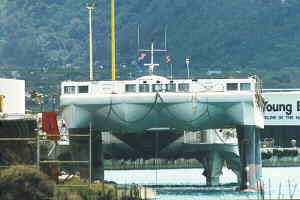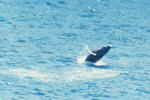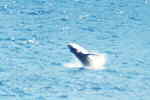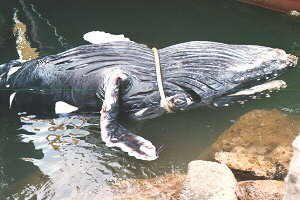
During the last year or so Hawaii's marine resources have been bombarded by various military tests and activities, all of which are supposed to be in compliance with the National Environmental Policy Act, Endangered Species Act, Marine Mammal Protection Act and other environmental laws. During February and March of 1998 the Navy presented our marine resources with two such activities, LFA & ATOC, that may have had significant negative impacts on the whale and other marine life in Hawai'i with little regard for public concern or impact.

Unfortunately the Navy has once again shown that Hawaii’s environment is, to them, nothing more than a proving area for weapons and warfare technology. Recently EnviroWatch, Inc. uncovered yet another special project conducted by the United States Office of Naval Research in Arlington, VA, involving the development of the Slice and Swath vessels in Hawaiian waters. The project is funded by 15 million dollars from the Department of Defense, acquired by Hawaii’s Senator Daniel Inouye. These super-fast vessels are reported to travel up to 31 knots while maintaining a 14 foot draft under the surface with their twin hulls (Slice). Our initial investigation of the vessels and their use show that they were not presented to the public as either a government or military project and, in fact, have been served up as the future interisland ferry with "possible military applications". The truth of the matter is that Rear Admiral Paul Gaffney II of the Office of Naval Research oversaw the development for the Navy in a public/private partnership.
 |
In an article in the Honolulu Star Bulletin, 12/8/97, Steven Loui, President of Pacific Marine & Supply Company, the builder of the vessel stated, "Slice was designed, built and tested in less than four years at a cost of 14.5 million which makes it one of the fastest, least expensive, advanced-craft development programs ever conducted by the office of Naval Research. Potential uses for Slice include as a missile launch pad, patrol boat, test-range support craft, helicopter support, and search and rescue". He also hopes to continue building [testing] Slice ships here for export worldwide. |
A review of the final Environmental Impact Statement and Management Plan for the Hawaiian Islands Humpback Whale National Marine Sanctuary found that the use of the Swath and Slice Vessels, or their development, was not disclosed in Appendix F "List of Military Activities in Hawaii". Also, Section C of the same document, "Known & Potential Impacts to Central North Pacific Stock, Subsection ii, Collisions by Ships" states:
"As ships get larger and faster, and if the numbers of vessels increase, the incidence of encounters can be expected to increase (NMFS 1991). Glockner-Ferrari and Ferrari (1987) note that the number of physical injuries to calves, juveniles, and adult humpback whales as a result of collisions with boats has increased in Hawaiian waters. It has also been noted that humpbacks seem less likely to react overtly to vessels when actively feeding than when resting or engaged in other activities (Krieger and Wing 1984, 1986). If such whales either accommodate to disturbance (Beach and Weinrich 1989) or pay less attention to ships when actively feeding they would have increased risk of collision. In the spring of 1996 a humpback whale calf was reportedly struck and killed by an unknown vessel off the west Oahu coast (G. Nitta pers. Comm.)."
EnviroWatch, Inc. has confirmed the accuracy of the above statements, and our own fears, in the fact that the Slice and Swath vessels have already had a negative impact on marine mammals and other marine life. On or about March 18, 1998, the National Marine Fisheries Service interviewed the Captain of the Slice after he reported a collision between the Slice and a whale or other large marine mammal. Of even greater concern is that NMFS is covering up the fact by not prosecuting the Navy or vessel operator after documenting the incident, nor have they considered future impacts and compliance with NEPA, which requires an analysis of potential environmental effects of major federal actions within U.S. territorial waters. We’ve also learned that NMFS only response to the incident was to write up an internal memorandum regarding the matter.

In March, during the Navy’s SURTASS LFA (Surveillance Towed Array Sonar System Low Frequency Active) System testing, a dead humpback whale calf washed up on Lahi Lahi Point, Waianae, on the Island of Oahu. The National Marine Fisheries Service (NMFS), the Hawaii Department of Land and Natural Resources (DLNR), and the Navy were quick to dismiss LFSA testing as the cause of death, though they did not disclose that the machines were being calibrated before the official start date and that the calibrations could also have had an impact on whales.
More ominous, if SLFA testing was not involved, they also never publicly acknowledged that the calf’s death could have been a result of being hit by either the Navy’s Slice or Swath vessels which were also being tested in the area.
| When we requested biological opinions or other assessments issued by NMFS regarding the Swath and Slice project the response was "We are working with the Navy on this". When we filed a FOIA with the Navy, requesting such information we received telephone calls from the Pacific Division, Naval Facilities Engineering Command, Environmental Planning Division advising " we don’t know what the vessel Slice is and we have no information on such a vessel" |  |
Arguably, our remarks regarding the whale’s death are mere speculation, but they do warrant some attention because the National Marine Fisheries Service and other government entities have ignored federal law. Given the fact that this project has been cloaked in secrecy and blatant disregard for federal law, we are left with but one choice; to attempt to bring to the public’s attention the circumstances surrounding the Slice and Swath project. You can read more about the Office of Naval Research and it projects by going to their web site at www.onr.navy.mil/sci_tech/industrial/slice.htm
 |
 |
|
| Already dead, | He could be next .... |